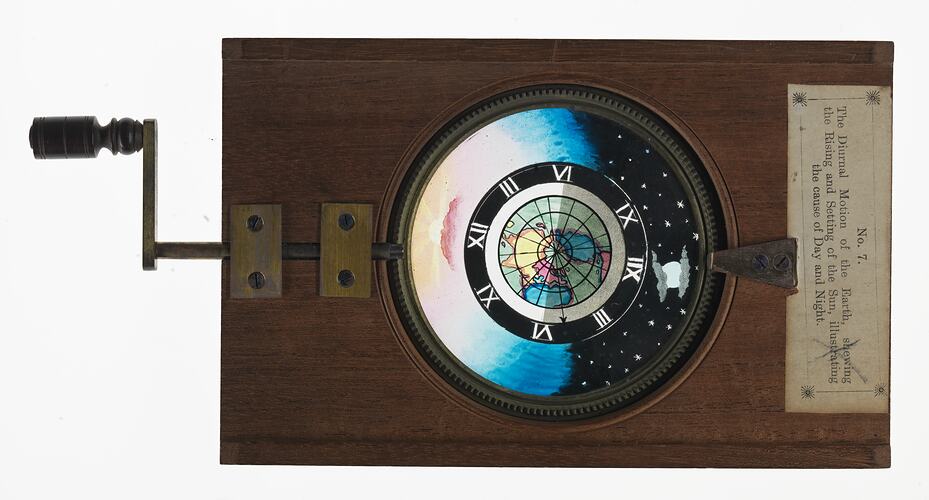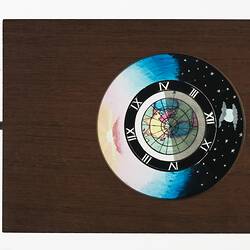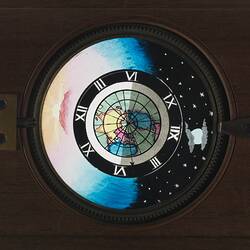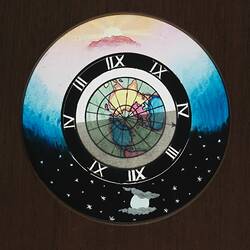Summary
This is a rackwork lantern slide with two glass slides, one fixed and one rotating, showing the cause of day and night. The lantern slide is part of a complete set of 10 slides used to illustrate a lantern lecture on astronomy; this slide is numbered 'No. 7'. This particular set was manufactured in England in approximately 1850, depicting astronomical knowledge about the planets as existed around that date. The set is unsigned, and so the manufacturer cannot be known for certain, although only a few manufacturers made unsigned sets. It was retailed in Melbourne by Charles Earle, Optician, who sold magic lanterns from his shop in Bourke Street from 1855 until his death in 1898. This set was used in Victoria in the nineteenth and early twentieth century by a relative of the donor. Precise details about its usage are unknown but equivalent sets were used in Australia in the latter half of the nineteenth century as can be seen from advertisements and descriptions in newspapers from the time.
Description of Content
The fixed slide shows an illustration of day and night, with an hour circle. The rotating slide has a picture of the Earth. When the slide is operated, the Earth rotates, showing the cause of day and night.
Physical Description
Astronomical Single Rackwork Slide. The slide consists of a rectangular wooden frame with two glass discs, one revolving in front of the other. The revolving glass disc has a metal frame with teeth around its edge forming a rackwork rim. A steel pinion with a matching toothed-end engages the rackwork and a handle is fixed to its other extremity which extends through one end of the frame. Light shines through the glass plate and illuminates the diagrams painted on the glass. There is a paper label stuck on the wooden frame with lecture notes.
Significance
Lantern lectures were one of the most prominent and popular forms of entertainment in the nineteenth century. In Australia they were presented in a range of venues including schools, churches, Mechanics' Institutes and by itinerant lecturers, as well as occurring privately in domestic settings. Popular lectures on astronomy were a particularly prominent theme for such performances and thus these lectures were one of the most significant ways in which public audiences engaged with scientific ideas.
A number of different sets of astronomical lantern slides were produced. Sets with static paintings or simple motions were advertised from the beginning of the nineteenth century. Sets of nine, and then ten, rackwork slides started appearing in the 1840s. The first such sets were manufactured by Carpenter & Westley; later, near-identical sets were produced by firms including W.E. & N, Newton, Dollond, W & S. Jones and Watkins & Hill. These sets continued to be sold throughought the nineteenth century and into the twentieth century, showing the durability of their appeal.The use of these sets within Australia can be readily discerned from newspaper reports and advertisements. One of the astronomical slides in this set, the 'orrery' slide, was particularly intricate and was regarded as one of the most sophisticated kinds of slides ever produced.
While many individual lantern slides survive, complete, or near-complete sets are relatively rare within public collections, especially sets of complex rackwork slides. As such this set is of international significance in providing a valuable insight into the complete performance of a technologically sophisticated astronomical lantern lecture, and the way that popular culture engaged with science.
More Information
-
Collection Names
-
Collecting Areas
-
Acquisition Information
Donation from Bill Franzke, 2008
-
Place & Date Manufactured
England, circa 1850
Dating of the slide set is based on the appearance of the planets and their moons in image number 1. Saturn is depicted with eight moons. The eighth known moon, Hyperion, was discovered in 1848 and so the image cannot be any earlier than this. Neptune is shown with a ring. This 'discovery', announced by William Lassell in 1846, was retracted by Lassell in 1852 so the images are unlikely to be much later than that. Additionally, Uranus is shown with six moons; four of these moons, 'discovered' by William Herschell were accepted as spurious by 1851. Thus the content of the images reflects astronomical knowledge as it was in 1848-1851, although it is possible that the manufacturer used outdated information making the date slightly later than 1851. The manufacturer is possibly Watkins & Hill, who operated between 1818 and 1857 and produced unsigned sets of rackwork astronomical slides in this time. However without a detailed comparison with other slides of known prevenance, this identification would be difficult to make precisely. -
Retailer
C. Earle's Optician, 158 Bourke Street East, Melbourne, Victoria, Australia, 1855 - 1898
The earliest advertisement for the retailer advertising magic lanterns for sale is The Argus, 17 Oct 1855 p6. The earliest advertisement for the retailer is from earlier in 1855. -
Format
Lantern Slide - Rackwork Type, Wooden Framed - Single Image, Hand Coloured
-
Language
English
-
Inscriptions
Slide label on back of wood frame, typed in black ink: 'No. 7. / The Diurnal Motion of the Earth, shewing / the Rising and Setting of the Sun, illustrating / the cause of Day and Night.' Handwritten in pencil on the slide label: 'X'
-
Classification
-
Category
-
Discipline
-
Type of item
-
Overall Dimensions
228 mm (Width), 15 mm (Depth), 112 mm (Height)
-
References
Bush, Martin, 'A history of popular astronomy in Australia in the era of the lantern slide: 1825-1910' (PhD thesis), Swinburne University, 2017 Butterworth, M., 'Astronomical Lantern Slides', The Magic Lantern Gazette, Vol. 19 (2) 2007, pp 3- 9. Gavine, D., 'Some early astronomical visual aids', Journal of the British Astronomical Association, Vol. 88, (1977), pp. 32 - 37
[Thesis] Bush, Martin. 2017. A history of popular astronomy in Australia in the era of the lantern slide: 1825-1910.
-
Keywords




